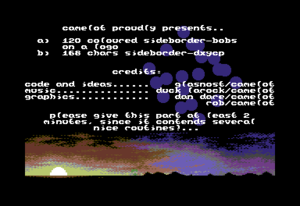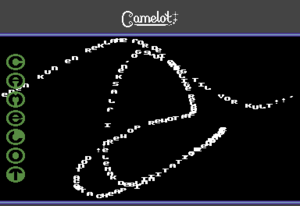
Commodore 64 demos
Encyclopedia


Commodore 64
The Commodore 64 is an 8-bit home computer introduced by Commodore International in January 1982.Volume production started in the spring of 1982, with machines being released on to the market in August at a price of US$595...
computer, made by programmers, musicians and artists.
Though it was not unusual to find demos that displayed a single picture, only music tracks or a programming skill. Groups were formed that consisted of members who were skilled in composing music, drawing graphics and programming. Full disk demos were produced, some of which would play music as the next file loaded, without any delay in the sound.
Various effects are achieved in demos, most of them due to undocumented side-effects pertaining to the MOS Technology VIC-II
MOS Technology VIC-II
The VIC-II , specifically known as the MOS Technology 6567/8562/8564 , 6569/8565/8566 , is the microchip tasked with generating Y/C/composite video graphics and DRAM refresh signals in the Commodore 64 and C128 home computers.Succeeding MOS's original VIC , the VIC-II was one of the two chips...
chip. Some examples are:
- Sprite scrollers were placed in the border. By tricking the hardware not to draw the border around the screen, sprites could be moved into this area and displayed.
- Sprites were multiplexed across vertical raster lines (over 8 sprites, sometimes up to 120 sprites). A common perception is that no more than 8 sprites could appear at once on the screen, but assigning new Y coordinates once it has started being drawn made it reappear further down the screen.
- FLD (flexible line distance) moved bitmap or character rows an arbitrary number of vertical raster lines apart, making it possible to arbitrarily move any 8 pixel high graphic block smoothly up and down across the screen. Adding sine curves to this positioning provided a wavy effect.
- FLI, or Flexible Line Interpretation, can be used to increase the number of unique colors which can appear in an 8x8 or 8x4 block on the screen. This mode is occasionally extended further with sprites and/or interlacing two bitmaps together (as in SHIFLI or UIFLI). These modes usually cause the left-most 24 pixels of the display to become unusable.
- FPP (Flexible Pixel Positioning), basically a variation of the FLI mode, allows the placement of any line of a character-based graphic at any one y-position, allowing for effects like x-rotating logos, barrel-like effects or smooth stretching and waving over the whole screen.
- Tec-Tec (also Tech-Tech or Tic Tac) assigns a new x-position to any line of a graphic. By using animated sine waves you could for example wave a logo horizontally over the screen.
- VSP (Variable Screen Positioning), also known as HSP, allows arbitrary x-placement of a bitmap, with the bitmap wrapping around at the border.
- A Linecruncher allows to scroll a bitmap larger than one screen vertically without having to move all the bitmap data manually.
- AGSP (Any Given Screen Position) is the combination of VSP and Linecruncher, f.ex. making possible games with colorful bitmap graphics that scrolled, such as Hannes Sommer's "Fred's Back" series.
Followers of the C64 would see the growth of the demo scene. Gone were the single file demos with one scrolling text and no music. Full disk demos were produced, some of which would play music as the next file loaded, without any delay in the sound.
Hidden parts were included as was the occasional game implemented into a demo.
When the Commodore Amiga
Amiga
The Amiga is a family of personal computers that was sold by Commodore in the 1980s and 1990s. The first model was launched in 1985 as a high-end home computer and became popular for its graphical, audio and multi-tasking abilities...
appeared, many former C64 demo programmers switched platforms and continued to make demos for the Amiga (see Amiga demos
Amiga demos
Amiga demos are demos created for the Commodore Amiga home computer.A "demo" is a demonstration of the multimedia capabilities of a computer . There was intense rivalry during the 1990s among the best programmers, graphic artists and computer musicians to continually outdo each other's demos...
). The Atari demos
Atari demos
Atari demos generally refer to demos created for the Atari ST home computer.- History :The Atari Demo Scene can probably be traced back to a group called "The Exceptions" who created a series of music demos in 1987. In 1988 the Atari Demo scene gathered further momentum with the release of the...
were also heavily influenced by C64 demos. In the United Kingdom
United Kingdom
The United Kingdom of Great Britain and Northern IrelandIn the United Kingdom and Dependencies, other languages have been officially recognised as legitimate autochthonous languages under the European Charter for Regional or Minority Languages...
, the main alternative demo scene was the one of ZX Spectrum demos
ZX Spectrum demos
ZX Spectrum demos are demos made for the ZX Spectrum and compatible computers. The demo scene on the Spectrum can probably be traced back to Castor Cracking Group, The Lords and a few other groups and individuals back in 1986...
.
The C64 was popular in a time when local BBSes
Bulletin board system
A Bulletin Board System, or BBS, is a computer system running software that allows users to connect and log in to the system using a terminal program. Once logged in, a user can perform functions such as uploading and downloading software and data, reading news and bulletins, and exchanging...
were also popular and used to communicate with other people. Software trading via mail
Mail
Mail, or post, is a system for transporting letters and other tangible objects: written documents, typically enclosed in envelopes, and also small packages are delivered to destinations around the world. Anything sent through the postal system is called mail or post.In principle, a postal service...
was also common. Some C64 enthusiasts lament the loss of the social interaction that locally centered computer activities provided.
External links
- C64.CH - The C64 Demo Portal, A site for C64 demos with screenshots
- [ftp://ftp.scs-trc.net/pub/c64 The Digital Dungeon (TDD)], FTP site for C64 demos
- Commodore Scene Database, A scene database where you can get in touch with the sceners themselves or get info about one scener or release or event. Structured, including information (hidden parts), downloads, screenshots, forum.
- C64 Portal C64 demo scene related news, about new releases, parties and other scene related news
- Intros.C64.Org Large online archive of crack intros, the first demoscene productions.
- Driven Online Driven Online - Covering the North American demo scene
- digitalmemoriesdvd.de, Digital Memories: C64 Demos - showcases C64 demos on DVD
- 8Bit Mayhem C64 Scene Music Podcast, Obvious, not so obvious, forgotten and classic Commodore 64 scene music.
- Commodore 64 and PET Demos, Early demos, most written before the demoscene
- Colourful raster bars code

